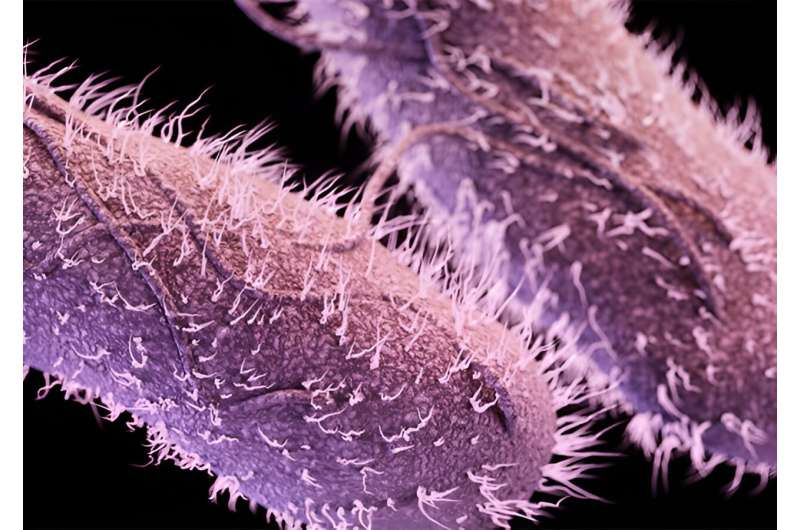This article has been reviewed according to Science X's editorial process and policies. Editors have highlighted the following attributes while ensuring the content's credibility:
fact-checked
peer-reviewed publication
trusted source
proofread
Study reveals how some bacterial infections become chronic

In the early 1900s, a cook named Mary Mallon, better known as "Typhoid Mary," spread Salmonella Typhi, the causative agent of typhoid fever, to dozens of her patrons even though she showed no symptoms. Many people today harbor pathogenic Salmonella bacteria for years without feeling sick, making them potential sources of new infections.
A new study by scientists at the Broad Institute of MIT and Harvard, along with colleagues at Tel Aviv University and the Sheba Medical Center in Israel, sheds light on the biological mechanisms that enable another kind of Salmonella to evade the immune system and cause long-term infections.
The team focused on the "nontyphoidal" forms of Salmonella, which cause foodborne illness and, like the typhoidal form, can linger in the body long after the initial infection. By examining the genomes of bacteria collected from hundreds of people with persistent Salmonella infections, they discovered genetic mutations that both reduce the bacteria's "virulence," or ability to infect, and dampen the host's immune responses, creating a kind of molecular camouflage that shields the bacteria from the immune system's gaze.
This insight could one day lead to new diagnostic approaches or treatments that prevent these infections from becoming chronic. The work appears in Cell Host & Microbe.
"In our group, we aim to use Broad -omics technology to understand the drivers of persistent infections including the role of pathogen genetics in modulating how the host responds," said Ashlee Earl, co-senior author on the study and director of the Bacterial Genomics Group at the Broad, where she is also an institute scientist.
"In a large collection like this, the patients represent 'natural experiments' that we can observe in parallel to uncover the genetic changes in the pathogen underlying persistence."
Salmonella subterfuge
To begin answering that question, the Earl group and the Broad's Microbial Omics Core team led by co-senior author and institute scientist Jonathan Livny connected with the lab of Ohad Gal-Mor, an assistant professor at Tel Aviv University who is co-senior author on the new study.
The Gal-Mor group had previously analyzed bacterial samples gathered from more than 48,000 people in Israel with salmonellosis between 1995 and 2012. By studying the samples, which had been collected periodically until each patient tested negative for the pathogen, they found that while most people cleared the infection after a week or so without treatment, roughly 2.2% of the cases became persistent infections that lingered for months to years.
In the new study, the researchers examined samples from 256 patients in the collection whose infections lasted at least 30 days. They confirmed that most of the cases were due to chronic infection by the same strain, rather than reinfection by different strains of the same bacteria.
After analyzing the genomes of Salmonella in patient samples at various time points, the team highlighted mutations in two genes, barA and sirA, that arose in the bacteria repeatedly during chronic infection.
These genes help regulate the activity of other genes, and further analysis suggested that mutations in these genes decrease the activity of a set of genes known as SPI-1 genes, which help Salmonella invade host cells. Animal experiments showed that the bacterial isolates carrying a barA or sirA mutation were less competitive than those lacking the mutations, indicating that the mutations reduced the bacteria's ability to invade and replicate.
To investigate the effect of the mutated genes on the host's immune response, the researchers infected mouse immune cells called macrophages in a dish with Salmonella with barA or sirA mutations. They found that the mutated bacteria dampened the expression of the macrophage's immune response genes, suggesting that the bacteria with misspelled barA or sirA genes provoked less of an immune response in the host.
The scientists then wondered whether these less virulent bacteria would even be able to sustain an infection. They found that, during long-term infection, mice infected with the less virulent Salmonella shed similar amounts of bacteria in their feces and had similar levels of bacteria in their organs as animals carrying the non-mutated bacteria, indicating that the less-virulent Salmonella could still maintain an infection that could possibly be spread to other hosts.
The mutated genes had different misspellings in different patients, suggesting that the bacteria evolve independently to lower the host immune response.
"These results show us that the pathogen is evolving within the host and potentially adapting to chronic infection," said first author Alexandra Grote, a postdoctoral fellow in the Bacterial Genomics Group at the Broad. "If we can better understand the pathways involved, it provides an exciting opportunity to develop new treatments or approaches to prevent the infections from becoming persistent."
More information: Alexandra Grote et al, Persistent Salmonella infections in humans are associated with mutations in the BarA/SirA regulatory pathway, Cell Host & Microbe (2024). DOI: 10.1016/j.chom.2023.12.001
Journal information: Cell Host & Microbe
Provided by Broad Institute of MIT and Harvard




















